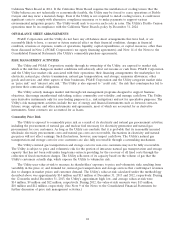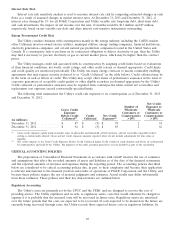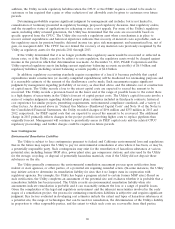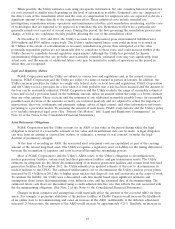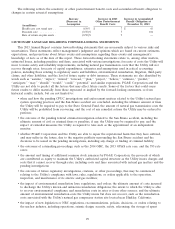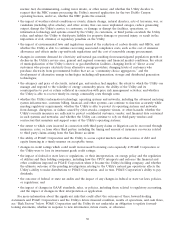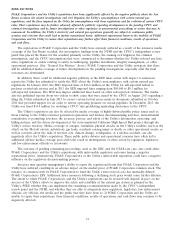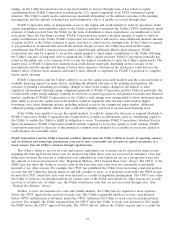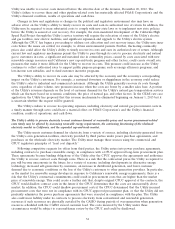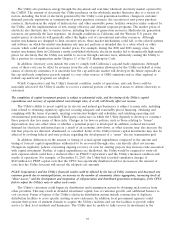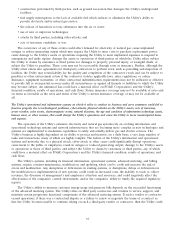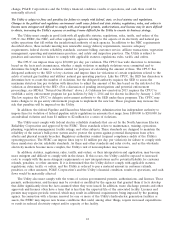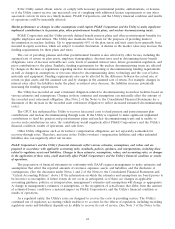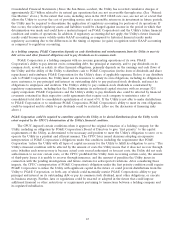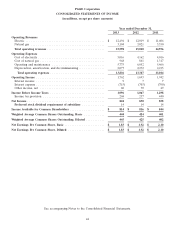PG&E 2013 Annual Report Download - page 40
Download and view the complete annual report
Please find page 40 of the 2013 PG&E annual report below. You can navigate through the pages in the report by either clicking on the pages listed below, or by using the keyword search tool below to find specific information within the annual report.Utility was unable to recover costs incurred before the effective date of the decision, December 20, 2012. The
Utility’s failure to recover these and other pipeline-related costs has materially affected PG&E Corporation’s and the
Utility’s financial condition, results of operations and cash flows.
Changes in laws and regulations or changes in the political and regulatory environment also may have an
adverse effect on the Utility’s ability to timely recover its costs and earn its authorized rate of return. In addition, the
Utility may be required to incur substantial costs to comply with new state laws or to implement new state policies
before the Utility is assured of cost recovery. For example, the state-mandated development of the California High
Speed Rail Project through the Utility’s service territory will require the relocation of some of the Utility’s electric
and gas facilities, new electric facilities, and significant expansion and upgrade to the Utility’s electric system.
Although the CPUC has begun a proceeding to address cost allocation and cost recovery issues, the Utility may incur
costs before the issues are settled, for example, to obtain environmental permits. Further, fluctuating commodity
prices also could affect the Utility’s ability to timely recover its costs and earn its authorized rate of return. Although
current law and regulatory mechanisms permit the Utility to pass through its costs to procure electricity and natural
gas to customers in rates, a significant and sustained rise in commodity prices, caused by costs associated with new
renewable energy resources and California’s new cap-and-trade program and other factors, could create overall rate
pressures that make it more difficult for the Utility to recover its costs. This pressure could increase as the Utility
continues to collect authorized rates to support public purpose programs, such as energy efficiency programs, and
low-income rate subsidies, and to fund customer incentive programs.
The Utility’s ability to recover its costs also may be affected by the economy and the economy’s corresponding
impact on the Utility’s customers. For example, a sustained downturn or sluggishness in the economy could reduce
the Utility’s sales to industrial and commercial customers. Although the Utility generally recovers its costs through
rates, regardless of sales volume, rate pressures increase when the costs are borne by a smaller sales base. A portion
of the Utility’s revenues depends on the level of customer demand for the Utility’s natural gas transportation services
which can fluctuate based on economic conditions, the price of natural gas, and other factors. In the GT&S rate case
application, the Utility has proposed that this revenue mechanism be eliminated beginning on January 1, 2015 but it
is uncertain whether the request will be granted.
The Utility’s failure to recover its operating expenses, including electricity and natural gas procurement costs in
a timely manner through rates could have a material effect on PG&E Corporation’s and the Utility’s financial
condition, results of operations, and cash flows.
The Utility’s ability to procure electricity to meet customer demand at reasonable prices and recover procurement-related
costs timely may be affected by increasing renewable energy requirements, the continuing functioning of the wholesale
electricity market in California, and the expanded cap-and-trade market.
The Utility meets customer demand for electricity from a variety of sources, including electricity generated from
the Utility’s own generation facilities, electricity provided by third parties under power purchase agreements, and
purchases on the wholesale electricity market. The Utility must manage these sources using the commercial and
CPUC regulatory principles of ‘‘least cost dispatch.’’
Following competitive requests for offers from third parties, the Utility enters into power purchase agreements,
including contracts to purchase renewable energy, in compliance with a CPUC-approved long-term procurement plan.
These agreements become binding obligations of the Utility after the CPUC approves the agreements and authorizes
the Utility to recover contract costs through rates. There is a risk that the contractual prices the Utility is required to
pay will become uneconomic in the future for a variety of reasons, including developments in alternative energy
technology, increased self-generation by customers, an increase in distributed generation, and lower customer
demand due to economic conditions or the loss of the Utility’s customers to other generation providers. In particular,
as the market for renewable energy develops in response to California’s renewable energy requirements, there is a
risk that the Utility’s contractual commitments could result in procurement costs that are higher than the market
price of renewable energy. This could create a further risk that, despite original CPUC approval of the contracts, the
CPUC would disallow contract costs in the future if the CPUC determines that the costs are unreasonably above
market. In addition, the CPUC could disallow procurement costs if the CPUC determined that the Utility incurred
procurement costs that were not in compliance with its CPUC-approved procurement plan, or that the Utility did not
prudently administer the power purchase agreements that were executed in compliance with the plan. The Utility
also could incur liability under its contracts to procure electricity from conventional and renewable generation
resources if such resources are physically curtailed by the CAISO during periods of over-generation when generation
resources scheduled with the CAISO exceed customer load. The costs incurred by the Utility under these
circumstances would be subject to reasonableness review by the CPUC and could be disallowed.
34


